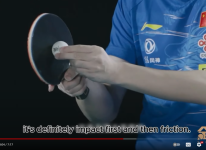Exactly for _blocking_ they are not easy. If you just put your racket behind the ball, it'll just pop up. You'll have to adjust the angle (might even not be possible) and/or actively drive it. They are easy to smash/punch or to counterloop, but you gotta be on the table or on top of the trajectory. OTOH you can exactly just block the ball if it has a lot of speed from the loop drive.
Also despite popular opinion, loopkills have the highest amount of spin, not slow spinny loops. This is why they're really difficult to block - there's huge spin + speed on them.
It is the ratio of spin to speed. The more there's speed, the less the spin is felt. That's why one can just hit through the backspin, because the racket speed is high.
Think of a loaded ball, which clips the net—all the speed is gone, there's just spin and no way to recover it by blocking, you gotta chop-block or whatever you try in this case, but most of the time the ball just shoots off.
I used to underestimate these loops myself, trying to hit a loop drive because:
1. The ball is heavy/rigid/whatever and doesn't spin very much.
2. Even with the old ball I used to play with a guy who was sitting on the table punishing these loops.
3. I'm tall and I couldn't open up/brush stably enough (think I'm not coordinated enough)
4. And in cases I could it was an easy point even for a mediocre opponent.
I just thought it's useless in the modern TT.
Lately I've figured out how to do it:
1. Consistently.
2. Spinny.
3. Short.
And it's a totally different story now. Against the lower level opponents it's a straight point and it's much more energy efficient than running around to hit a loop drive.
I have a strong sparring, who was ratingscetral 2100 in his prime. He comfortably spots me 6 points and I still struggle. During the training he naturally destroys all these openings, but I think he barely counterloops 20% of them during the matches.













